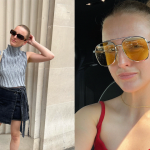When the lights went black at Undercover we waited for the usual procession that signifies a show’s finale. It didn’t come. Instead three models materialized out of the darkness wearing strapless dresses whose skirts seemed to light up. From a distance they looked like movie projections, but as they approached it became clear the skirts were glowing from within. Moving closer still, you saw the colorful flowers, and, wait, was that a butterfly flitting around? Why, yes, it was.
Jun Takahashi is one of fashion’s most inventive designers, but the terrarium dresses were a new level of ingenious, a technical feat as well as an emotionally resonant one. Through an interpreter backstage, Takahashi shared that he was grieving for people he was close to. “He feels like he’s stuck in the world, but he wants to release himself.” The butterflies, the interpreter made sure to add, “will be freed, of course.”
Reckoning with mortality was an undercurrent of Takahashi’s show last season as well. It’s said that grief doesn’t end, it only changes. That it can produce powerful work was proved today. This was Takahashi at his most focused: the leitmotif that carried from the first suit to the final terrarium dress was transparent veiling or shrouding. To start, he showed neat tailoring, the sheer materials exposing the inner construction and the items he slipped between the front and back sides, like playing cards, straight razors, and silk flowers. On a camel trench the outer layer encased a set of feathered wings—the soundtrack was lifted from Wings of Desire, the Wim Wenders film about angels on the lookout for humans in distress.
Later on came more formal suits, not see-through but swathed in more black georgette. They were as elegant as any tailoring anywhere this season, but Takahashi isn’t someone who seems to look around at what his peers are doing; for one thing, he’s too busy. Three of the looks here reproduced portraits from his first-ever oil painting exhibition, “They See More Than You Can See,” held in Tokyo earlier this month. Like the figures on his canvases, the faces on the deeply ruffled skirts had their eyes deleted, or disappeared, an eerie effect that was echoed in the other figurative pieces, which reproduced the surreally beautiful paintings of the German artist Neo Rauch. At his art show in Tokyo Takahashi said “painting is more personal,” but we beg to differ. This was a deeply personal show and it was a spellbinder.



